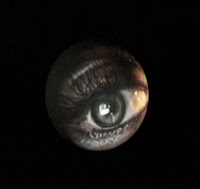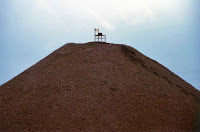The eye of Janus
The range of scientific approaches building the concept of Global Vision, plus contributions from the world of arts and humanistic culture, provides the material with which the Global Complexity Art builds the creative framework of a metaphorical "Window on the world" opening the panoramic site of global changes. On the other hand, considering the anthropological involvement enacted by the Global Vision, the best definition of the Global Complexity Art is "the art of seeing the world". To this creative outlook is fitting well a saying of Marcel Proust: "It is not important to see new landscapes but in having new eyes". In fact the evolving of “new eyes” is what the Global Complexity Art implies, by promoting the correct parameters for a new way of looking at the world. This means to provoke a new sensibility opening the eyes on the reality of our existential dimension, to overcome the typical egoistic nearside trough the opening of mental spaces, as necessary premise to see the world with the real local-global interaction in which we live every day. It is the art of seeing trough the Global Vision over the real world extended in space and in time. The “art of looking at the world” is like creating a mental hologram with images of the world formed by stratified sediments created by time evolving from the past to future. It means creating a virtual image composed by the constellation of archaeological remains testifying historical dynamics, traces of events and signs of changes crystallized by time in drawing the historical topography of the global landscape. It means to create a project with the heredity the world traced in time and which is waiting to be coordinated with contemporary developments to be projected into the creation of the future. In this sense the great Russian semiologist Mikhail Bachtrim called the world a "great chronotope", meaning a topography of time, which evolves from earliest origins by projecting it selves -thanks to human creativity- in the best of possible futures. Ultimately, the Global Complexity Art locates it selves in this time stream, painting the picture of the present situated between past and future, where, in fact, is rooted our true identity as well as the authenticity of any creative project. It’s simply the real human identity recorded in our DNA, as in the genetic memory of any living being, which leads to admit that we are all children of the Earth and members of the human family plus being related to the other inhabitants of this planet. In this view our awareness may rises until the appropriate level to become a real citizen of the world, as people of a global society having in common what Edgar Morin calls "Fatherland-Earth."
.jpg)
The eye of Janus
Undoubtedly the Global Vision seems to incorporate the bi-perspective vision of the ancient god of time Janus, but in addition it presents the propriety of a temporal compression, in harmony with the time-space implosion, already defined by McLuhan, due to the rapidity of global transportation and instant information. Therefore we can talk about a historical time-compression, as a culturally activated extension of real-time communication, or a part of the cultural evolution of an "extended present" advancing with global instant information systems. No doubt we are dealing with the generalisation of a new level of conscience, but surprisingly similar to an ancient biblical text: “Thousand years are for you like one day”. In this new vision of time-compression, just to make an example, the contemporary melting of glaciers, caused by atmospheric warming connected with industrialisation, appears to be the last phase of the dissolution of Ice Age which started 10.000 years ago with the rise of present Solar Age. Similarly the contemporary destruction of the last archaic tribal communities represents the end of the primal social form of humanity, in force during the Palaeolithic Ice age until the Neolithic revolution gave rise to city-states, in fact the destruction of tribal communities began with the grow of historic city-state systems which, by evolving, gradually came to dominate the entire world, and still continues to eliminate the remains of archaic cultures near to extinction. In conclusion it is with the same Global Vision of space-time compression that the Global Complexity Art composes the dynamic image of contemporary humanity, to paint a virtual fresco depicting the advent of "global man" and the renewal of his habitat in scale of man and nature.
|
|
|
-The felt hat-
Performance "The art of seeing the world" |
For the interdisciplinary approach, together with the Global View on humanity inspiring its creative activity, one can say that the Global Complexity Art continues the path indicated by the great German artist Joseph Beuys. “Passing on the torch” was an image he used to refer at. Along with its charismatic figure of shaman and great teacher, his work of great complexity is considered the highest artistic expression of the second half of twentieth century, while his teaching continues to be basic to the future of art in the world. According to Mario B. Montandon "the entire third millennium will have its roots in the thought of Beuys". In summary the work of Beuys is based on the interdisciplinary relationship between art and science elaborating the connection nature-culture; with an approach definable neo-humanistic not only because it recalls the versatility of the genial artists-scientists of Renaissance Humanism, but also because it involves equally the varied issue of human emancipation. "It is important -says Beuys- that humanity emancipates to a new humanity." Also if the language has changed between old humanism and the neo-humanism of Beuys, for both the anthropological evolution of humanity is seen in proportional relationship to the development of human creativity; a creativity not to be induced but to be "liberated" as a innate and therefore natural human faculty. "I try to bring to light -he said- the complexity of creative areas." Therefore Beuys gives great importance to the relationship art-man, demanding the development of social systems the necessary cultural space to exercise what is a peculiarity of mankind, his free will, to which Beuys referrers as a prerequisite to release the innate creative potential that is rooted in the anthropological identity of every human being. What is well expressed in his famous motto "every man is an artist." In logical connection with his evolutionary view of humanity’s potential creativity, Beuys developed the concept of "extended art", a generalisation of human creativity, aimed to involve the entire spectrum of human activity in a evolutionary dynamic that elevates human labour to the level of art. A comparison could be seen in the relationship between art and handicrafts in the Middle Ages. For Beuys the new concept of "extended art", since it involves progressively the whole society, in a historical perspective it will equally engage a creative evolution in the global conformation of human habitat, trough which the entire world will turn into a "work of global ecological art". In this sense Beuys considered each of his works a conceptual step farther towards the collective “global art work” of the future world. According to Beuys only in this direction of creative evolution will gradually fades the contrast culture-nature, the alarming ecological situation build up by modern industrialisation and associated positivistic frame of science. In fact the matching of natural creation and cultural creation is a basic pattern of humanistic thought. The originated can be traced back to the Platonic concept of nature "as a work of art", quoted also by Lorenzo de Medici in one of his sonnets, to be considered a basic paradigm for the beauty of art and architectonic structures in ancient Greek and renaissance, created to mach the beauty of nature by adopting the “golden proportions” that underlies natural world: this reflection between natural or divine creativity and human creations achieved the great harmony between culture and nature in Ancient world as well in Italian renaissance. In a contemporary view, elaborations of this kind of concepts are sustained by the Science of complexity, trough which the Global Complexity Art gives particular relevance to evidences of creative continuity between the natural universe and the artificial world of humanity. For more details I advice to read "The felt hat" written by Lucrezia De Domizio Durini (Secret Cards Editions 1991).
|
The Psiche
Video: Veil-Unveil-Reveil |
What can be defined as the neo-humanist utopia of Beuys finds some interesting comparison and anticipation within the Renaissance humanism. Starting with the enlarged artistic creativity extended in many different fields, with the creation of an admirable set of works generally considered an utopian model of the future; where has to be considerate that renaissance imaginary went from the beginning to the end of history, meaning that the utopia regards a world project. This historical experience represents exactly what Beuys called "concrete utopia", since it was an utopian model that in reality created the foundation of modern European culture, which trough its colonial exportation extended in the evolution of the Modern World. In addition it is not said that the propulsive energy of Humanism come to an end, considering that neo-humanistic thought involves many intellectuals and artists who believe in an humanistic evolution of the future. Similar comparisons apply to the relationship between creativity and human evolution, considering that for Renaissance humanists the artwork has the effect to stimulate and cultivate our five senses, raising man from the gross state to higher levels of refinement. In practice, the senses are called "gates of the soul" through which the works of art refine and purifie the soul from obsolete remains of animal instincts, raising the emotional impulses over the sphere of reproduction, trough that the soul enlightens to universal creativity in the likeness of the Creator. In that sense Renaissance artists, as universal creators, were considered closer to the human model defined by the Bible "in the image and likeness" of the Creator. In fact some great painters of the time painted themselves in the likeness of the Creator; see Perugino, Dürer, Leonardo etc. In practice the artist is the anthropological model of humanism. In fact, under the anthropological profile, it is exactly the visual creation, the imaginative creation of images, to find a specific relevance in humanistic thought, trough the evident connection between human creativity and the capacity to create images, where imagination is the faculty enabling man to create images. The old texts speak about the basic function of the "Imaginatio", operating through an inner eye similar to the enlightened "third eye" in Hinduism, which in the Western culture finds analogy with the "Eye of God", equally represented as only one eye, denoting the Creator, in whose likeness artists create their images. In fact, the inner eye of imagination, sensitized and cultivated to interact with all senses and therefore defined as "common sense", meaning all senses concentrated in the sense of vision connected with the light of consciousness, that illuminates the perception of images created out of the invisible reality behind the phenomenological surface of things: here we have the human creation as intermediary of divine creation. Not surprising that in all traditional cultures it was with the works of artistic creativity that people honoured the Creator, which made the ancient relation between art and religion. While the psychological existence called “soul” is securely in a main consideration of all religions, not the less the soul is a central reference in the world of art, starting with inner inspiration to conclude with artworks involving our emotions. As the soul is the object of religions defined “way of salvation”, so in humanistic art the soul is the object to deal with, to awake, cultivate and refine its emotional pulsation, to “sublimate” our animal instincts said Freud; in other words the artistic input reconditions conditioned reflexes by recoding the lower “appetites” moving the soul, as taught Plato and Aristotle. Those ancient philosophers wrote important books on this subject, elaborated in humanistic thought, by defining the structure of the soul like a pangenetic memory, we could say a semi conscious DNA, interacting with the analogous “soul of the world”, another important segment of traditional cultures. One can conclude there is no anthropological evolution without involvement of the interior world, the deep going layers of the psychic sphere. No surprise if Joseph Beuys, in his neo-humanistic intends, enacted particular emphasis on involvements of the soul by interpreting his figure as artist projected in the image of a Shaman, the prototype of healer in archaic animism to which the underlying reality is composed by interacting souls; it is also the common ground from where evolved historic religions, between which Beuys imagined to create interaction of epistemological renewal. With this complex meaning Beuys symbolized the Shaman with his gilled as “fisher of souls” and his famous “felt hat” as guiding healer of mankind on the path of evolution.
.jpg)
+Psiche+diTenerani+(10x15-100)+WEB.jpg)